

Ethan's Audio and Music Page. Ethan's Audio and Music Page THE 1960s One of my first electronics projects was in 1962 at age 13, when I built a low-power AM radio transmitter.
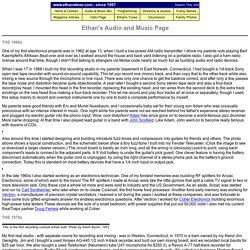
I drove my parents nuts playing Bert Kaempfert's Afrikaan Beat over and over as I walked around the house and back yard listening on a portable radio. I also got a ham radio license around that time, though I didn't find talking to strangers via Morse code nearly as much fun as building audio and radio devices. MasteringElectronicsDesign.com : Tenma 72-7745 Multimeter Review. A few weeks ago I received a Tenma 72-7745 multimeter and I have been using it since.
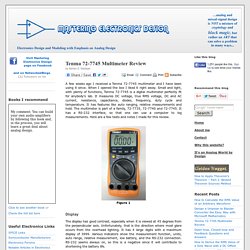
When I opened the box I liked it right away. Small and light, with plenty of functions, Tenma 72-7745 is a digital multimeter perfectly fit for anybody’s lab. It measures DC voltage, true RMS voltage, DC and AC current, resistance, capacitance, diodes, frequency, duty cycle and temperature. It has features like auto ranging, relative measurements and hold. Untitled. Basic to Advanced Battery Information from Battery University. Basic to Advanced Battery Information from Battery University.
Rechargeable Battery Protection Circuit. This project, a rechargeable battery protection circuit from 1991, is design that uses a MOSFET device to disconect a load from the circuit when the output of the load goes below a certain threshold.
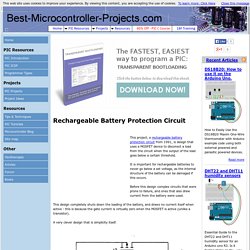
It is important for rechargeable batteries to never go below a set voltage, as the internal structure of the battery can be damaged if this occurs. Before this design complex circuits that were prone to failure, and ones that also drew current from the battery were used. This design completely shuts down the loading of the battery, and draws no current itself when active - this is because the gate current is virtually zero when the MOSFET is active (unlike a transistor).
A very clever design that is simplicity itself. Executive Summary of the Rechargeable Battery Protection Circuit A field-effect transistor is coupled, to conduct current from a rechargeable battery, to a load, so long as the voltage potential across the rechargeable battery is sufficient to turn on the field-effect transistor. Using the ESP8266 module. I obtained my module from an Ebay vendor in the United States.
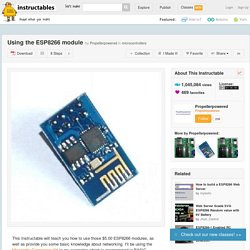
The shipping was faster than China, but more importantly, the vendor provides the module without the pins soldered in. The 8266 module isn't really breadboard friendly, but it's easy to convert it to a four pin module if you purchase the pin-less version. Understanding RC LiPo Batteries. It would seem by the number of e-mails I get on the topic of RC LiPo Batteries, it's time to build a page to help answer the most common questions.

Charging Some Of My LiPo Packs I've been into LiPo electric powered RC flight for the better part of 9 years now, and have learned so much about this amazing powering method in that time frame. Made some fairly costly mistakes as well! Home Automation. Home Automation. X10 RF Receiver - Tuning the XY-R03A-1 or RM1SG Super-Regenerative Receiver to 310 MHz.
PIC16F84A controller - CodeForFun.it. For making a multicolor lamp I’ve used a PIC16F84A which controls a rgb led.
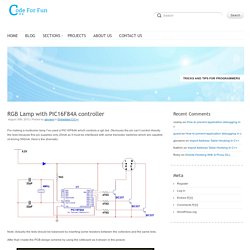
Obviously the pic can’t control directly the leds because this pic supplies only 20mA so it must be interfaced with some transistor switches which are capable of driving 500mA. Here’s the shematic: Note: Actually the leds should be balanced by inserting some resistors between the collectors and the same leds. After that I made the PCB design scheme by using the Ultiboard as it shown in the picture: Well, now I used the photoincision technique for making the PCB, particularly I bought a presensitized plate.
After that I ascertained that everything were ok, I started drilling and assembling taking care to assembly for first the resistors, the capacitors, the pic slot, the transistors and, at the end, the power jack and the rgb leds. c66n1401_i2c_adc_pwm_manual.pdf. I2C-based H-bridge controller with PWM. Android USB Charging Secrets. We all want our Android devices to charge faster.
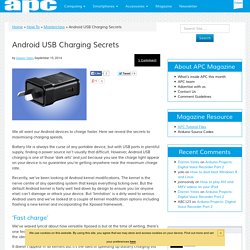
Here we reveal the secrets to maximising charging speeds. Battery life is always the curse of any portable device, but with USB ports in plentiful supply, finding a power source isn’t usually that difficult. However, Android USB charging is one of those ‘dark arts’ and just because you see the charge light appear on your device is no guarantee you’re getting anywhere near the maximum charge rate. Recently, we’ve been looking at Android kernel modifications. X10 filters. X-10 is an ancient powerline communication protocol that refuses to die because it runs over existing mains cabling, and is deceptively easy to get started on.
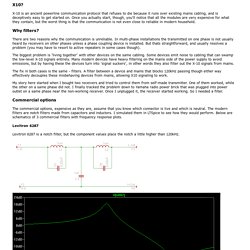
RasPi as an X10 server. RasPi as X10 server Unlike all my other articles this article will be in English: My Raspberry Pi is now an RF X10 server!
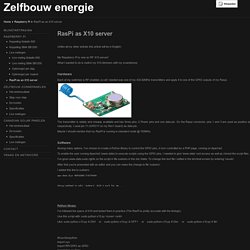
Raspberry Pi Car Computer - JackenHack. Update: You can find my latest update on the progress of my Raspberry Pi Car Audio System here.
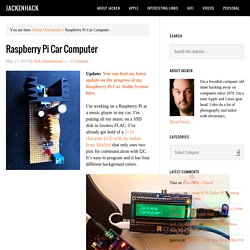
I’m working on a Raspberry Pi as a music player in my car. AVR ATtiny USB Tutorial Part 1. I wanted to build an USB device using AVR microcontrollers since I found out that it was possible. However, both the USBtiny project and the more extensive V-USB library lacked an easy-to-approach tutorial. So I decided to make one. This first part covers the basics for making USB-powered devices, and serves as introduction for second part, which goes through simple example for using V-USB library to implement USB communication to and from ATtiny2313.
Additional parts might be published later if I have the time and there’s interest. But let’s get started. USB cable and pin headerSmall breadboard and a few jump wiresLED and 330 ohm resistorLow voltage drop 3.3V regulator, such as LD1086V33 or LE33CZ. Portable Power for your Pi. There are plenty of interesting projects that require your Pi to be untethered from its mains power supply, or require a separate 5V supply that is capable of providing more power than is available from the Pi’s GPIO pins – here’s one way to do this. The main requirement is to provide suitable regulation at 5V, with sufficient current capacity for your project. Arduino Thermostat. Worksheets - Test your knowledge! Arduino Laser Show with Full XY Control : Download Code and Upload it to Arduino. Replacing old capacitors. When planning to restore old radio sets, common questions are: ‘How many capacitors should I replace?’
Home Automation Knowledge Base. Forums - Salvation For Your Electronics! USB IO Board PIC18F2455 / PIC18F2550. USB IO Board can be controlled with just about any serial port emulation program such as Hyper Terminal that comes with every Windows OS. The problem with Hyper Terminal is that you can't see the commands as you type them and that could be very annoying. With Hyper Terminal you also have to go through the wizard for setting up a serial port connection, and if the COM port changes you pretty much have to do it over and over again. Luckily we have released our own little application called USB IO Board Controller that is so much easier and fun to use than Hyper Terminal. It only takes 25KB of space so it's very lightweight. USB IO Board Controller will also show you COM port of USB IO Board so that will save you the trip (and time) to Device Manager to find out USB IO Board COM port number. To use USB IO Board Controller select the COM port from the drop down list, type the command and hit "Enter" key (or click on Send button).
Download USB IO Board Controller (Win 2K, XP, VISTA, Win7)